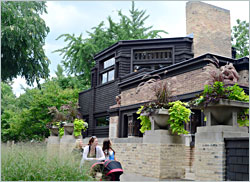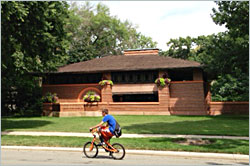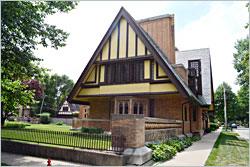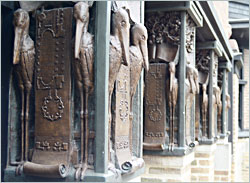Wright in Oak Park
After more than 125 years, the architect's first works still seem stunningly original.

© Beth Gauper
Around Frank Lloyd Wright's old stomping grounds in Oak Park, Ill., 2014 was a big year.
Of course, every year is a big year at the architect's first home and studio, which draws crowds of people from around the world even when it's not celebrating its 125th anniversary.
People come to Oak Park for the sensational stories as well as the architecture. Wright was notoriously ill-behaved, breaking promises and scoffing at rules. He was a genius, and he knew it.
As a tourist, you don't need to know anything about architecture to see exactly how much of a genius he was. Just tour his home and studio, then look across the street: Suddenly, those prettily painted Queen Annes look painfully lame.
Wright would have said bourgeois and derivative, which made him not the most popular man in Oak Park even before he abandoned his wife and six children to run off with the wife of a client.
Wright was no saint, but his work was divine.
It's treated with great reverence in the Chicago suburb of Oak Park, where Wright built his first home in 1889 with a $5,000 loan from his employer, Louis Sullivan.
"This is a very special place," said Mark Campbell of the Frank Lloyd Wright Preservation Trust, at the start of our tour. "This was Frank Lloyd Wright's first house, and all of the others came after. This was the No. 1 house that he created for himself."
Wright expanded the house in 1895 and added the studio in 1898. After he left in 1909, he redesigned the building to provide rental income for his family.
It fell into disrepair and, in 1974, was turned over to the National Trust for Historic Preservation. It spent 13 years and $3.5 million to restore it to the appearance of 1909.
Technically, it's Victorian, built in the Shingle style. But it has diamond-paned casement windows, octagonal bays and a giant gable that shelters the first floor with a tell-tale long horizontal line.
"Experts say you'll never find a Shingle-style house anywhere in the country that looks like this one," said our volunteer guide, Gary Palese. "He's really starting to break down the Victorian style; he wants to create something new."
Inside, he led us from living room to dining room, gleaming with quarter-sawn oak and the colors of earth and stone.

© Beth Gauper
Everywhere, we saw inspired details: friezes and skylight grilles, painted linen and leaded panes. A children's playroom Wright added in 1895 had almost too many details to take in: a barrel-vaulted ceiling, cantilevered window seats, a loft gallery and a mural inspired by the Arabian Nights tales.
By the time we got to the studio/drafting room, where a chain harness holds up a second-floor loft, and the library/office, with its three levels of octagons, we were overwhelmed by his ideas.
Wright's mind must have been going a mile a minute. He even designed a series of columns at the entry to his studio, incorporating the tree of life, the book of knowledge and storks, a sign of wisdom and fertility.
Over lunch in downtown Oak Park, we discussed the nature of genius. Do nice people ever create great works, or does one have to be a jerk?
Then we returned to pick up an audio tour. The surrounding neighborhood now is the Frank Lloyd Wright-Prairie School of Architecture Historic District, with 27 buildings designed by Wright.
Our favorite was the 1902 Heurtley House, just down Forest Avenue. It's full-blown Prairie style, with strong horizontal lines and a hipped roof, and we envied its owners.
The 1895/1923 Nathan Moore house was across the street, his first commission in Oak Park after leaving Sullivan. It combines elements of European cathedral with Tudor, with details that include a fence of giant concrete acorns.
And on a nearby court, the 1906 Laura Gale house is considered a "little Fallingwater," after the masterpiece Wright designed nearly 30 years later in Pennsylvania.
We didn't like the audio tour, however. It was impersonal and heavy on architectural theory, and it rushed us through the district.
Of course, we could have stayed there until the sun went down and still not seen as much as we wanted. Wright's legacy is too much to absorb in one day.
Trip Tips: Frank Lloyd Wright in Oak Park, Illinois

© Torsten Muller
Getting there: Oak Park is 10 miles west of Chicago's Loop. From there, it's a half-hour ride on the Green Line train to the Oak Park stop, then an eight-block walk to the Home & Studio.
The district also is just north of I-290, the Eisenhower Expressway.
Wright Home and Studio: The Frank Lloyd Wright Preservation Trust gives daily tours of Wright's home and studio. On summer weekends, it's wise to reserve in advance.
Guided walking tours of the Frank Lloyd Wright Historic District are offered on Saturdays and Sundays.
Self-guided audio tours are available every day, but try to take the guided tour if at all possible. Narration on the taped tour is rushed and rather dry, and it's difficult to juggle both the audio device and a camera.
If necessary, a better option is to buy the Fan Guide set of cards, which includes photos, commentary and maps and covers more houses.
The Chicago Architecture Center gives many tours that include Wright buildings, including Sunday walking tours of Wright-designed buildings in Oak Park.

© Beth Gauper
It also offers the four-hour Frank Lloyd Wright by Bus and Frank Lloyd Wright Neighborhoods by Bus. Both leave from the CAC Shop & Tour Center on Michigan Avenue.
Special tours: The annual Wright Plus Housewalk, a tour of buildings in Oak Park and adjoining River Forest, is held in May and sells out far in advance.
Other attractions in Oak Park: The Ernest Hemingway Birthplace and Museum are at 339 and 200 N. Oak Park Ave., not far from the Wright Home & Studio. They're open for tours.
Visitor information: Oak Park tourism, 708-848-1500. The visitor center is at 1010 Lake St. in the downtown district, which has many shops and restaurants.
More Wright in Chicago
Tours of Wright's 1910 Prairie-style Robie House, on the campus of the University of Chicago, are available Thursday through Monday.
In the Loop, short tours of the lobby of the Rookery are given at noon Monday-Tuesday and Thursday-Friday. The 1888 building was designed by Daniel Burnham and John Root, but Wright redesigned the interior court in 1905.
For more Wright sites in the Upper Midwest, see Loving Mr. Wright.
For more about Wright in Oak Park, read Nancy Horan's novel "Loving Frank," about his relationship with the ill-fated Mamah Borthwick Cheney.
For more Wright in Spring Green, Wis., where he built a home and studio after leaving Oak Park, see Drawn to Spring Green.